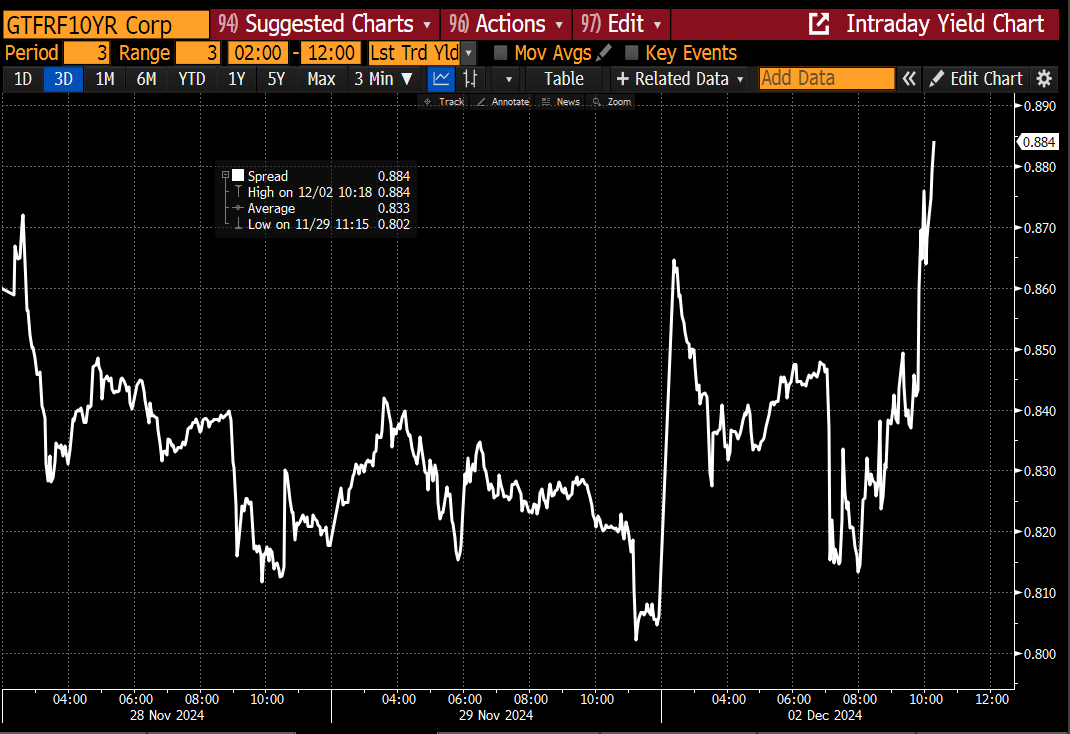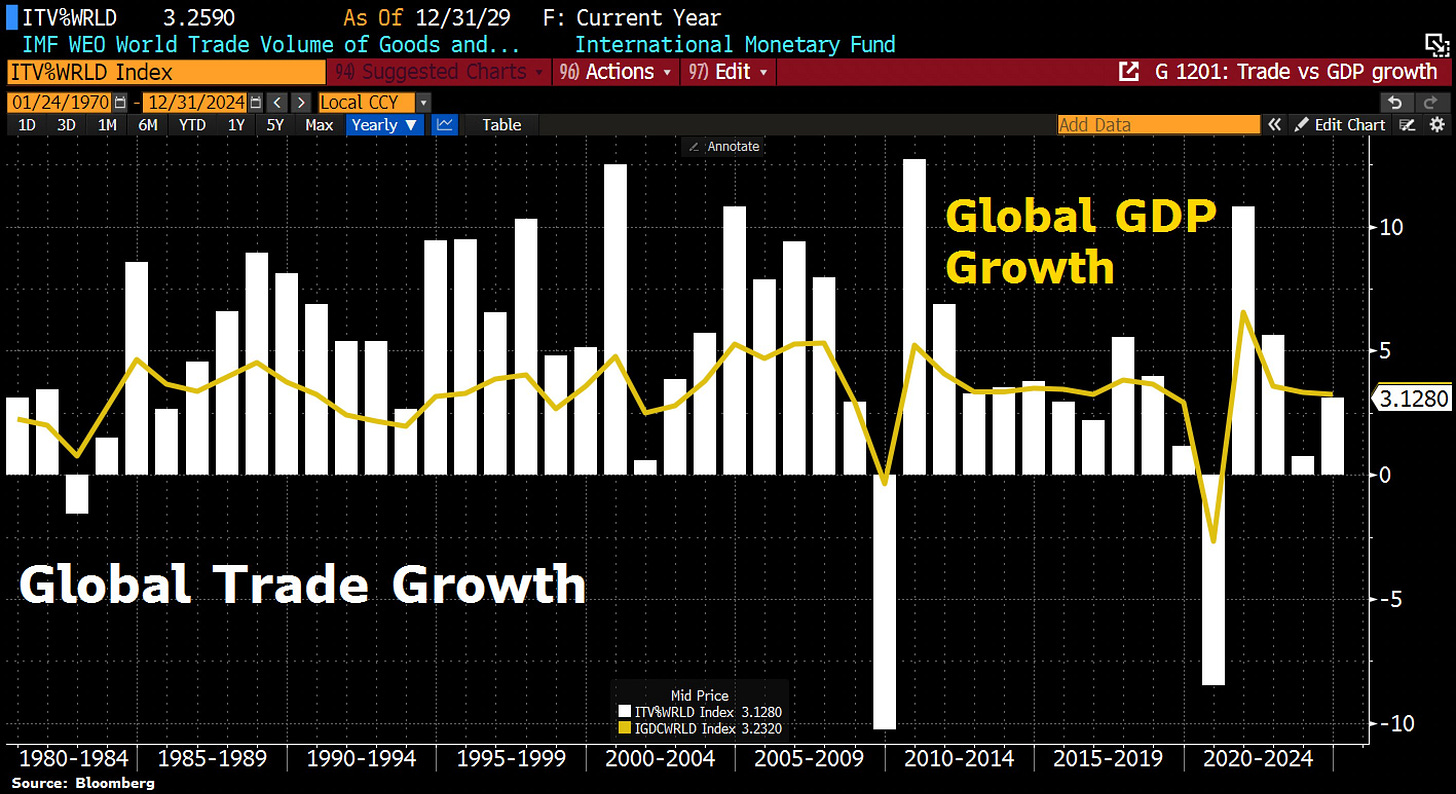Monetary and Fiscal Crossroads: The U.S. in 2025
Exploring the Fed's Decision: To Cut Rates or Hold Steady?
Happy Sunday MMH readers,
An overload of quantitive trading data to go through last week forced me to skip a report, which is uncommon here. So this week is a big one.
However, a very quiet week last week in the markets due to U.S. thanksgiving, happy belated thanksgiving to all our U.S. readers!
2025’s portfolio allocation is being planned out, the U.S. being the driver of many decisions made.
Let’s get into what’s going on over there.
Macro watch
The “Trump Trade” is beginning to lose some of its momentum, which is understandable given the rally’s we have seen across markets over the last 4 weeks.
The thing that didn’t help the Trump trade was the U.S. services PMI. Expectations were a lot higher going into the data release because of optimism surrounded by Trump’s policies, in favour of both the services and manufacturing industry. The reading for November was 52.1 from 56.0 in the previous month.
This isn’t something to be worried about, we’re still in expansionary conditions. However, the reason I took focus on this and a few other data point over the last few months is because the exceptional expectations expected from Trump may see actual data readings fall short, so the surprise indexes may see some extra points to the downside. Trump’s performance isn’t measured off of immediate actions, it’s over the course of the next 4 years. So, when expectations are so high for readings like services PMI, it makes sense as to why actual data falls short because nothing has really changed and won’t for at least a couple of months.
Market mover
France is facing a severe political crisis after Prime Minister Michel Barnier's government was ousted by a no-confidence vote. Barnier, with 331 votes against him, was forced to resign, plunging the country into instability. As a result, France may be heading towards legislative elections in June 2025, and potentially (but unlikely due to firm words on finishing his presidential term) even a presidential race, as Macron's authority is weakened. In the immediate term, the government will function under a caretaker administration.
No new laws will be implemented, however, A special law will roll over the 2024 budget, allowing the government to make necessary adjustments like the annual adjustment of income tax brackets, which will prevent tax increases that could burden millions of households.
Just look at the effect in the OAT-Bund spread, the largest seen since the Eurozone debt crisis in 2012.
Financially, while the budget rollover will lead to a slight reduction in the deficit, this is still insufficient to meet the targets set by the European Union. The country’s debt situation remains dangerous and the gap in interest rates between French and German government bonds may continue to widen, though it is unlikely to lead to a full-scale financial crisis due to the protection offered by the eurozone.
Political paralysis will have real consequences for the French economy. Growth is expected to slow further, which will increase challenges in the labor market, and the ongoing instability will put additional strain on public finances. The combination of sluggish growth and a widening deficit will make it harder for France to meet its long-term fiscal commitments.
From an investment standpoint, the absence of a budget and the left-wing coalition’s decision to forgo proposed tax increases are viewed as moderately favorable for savers. There will be no immediate hike in income taxes or alterations to the flat tax, ensuring short-term protection for investor returns. Additionally, the anticipated decline in interest rates across the eurozone is expected to bolster investment conditions in the broader European market. However, French companies, especially those reliant on the domestic market, are likely to face continued challenges, with their stock valuations remaining under pressure due to persistent political and economic uncertainty.
Although the likelihood of an imminent financial crisis is low, the ongoing uncertainty is expected to significantly impact the economy, dampen growth, and undermine investor confidence. With the next elections not scheduled until 2025, the country is poised for an extended period of political instability, posing challenges for both policymakers and the general public.
France, you are now in the same boat as Greece.
Monetary crossroads - Theme 1 (2025)
Going into the last Fed meeting of the year, which was split between a cut and a hold in the OIS market, comments from members has been key to listen to. Jerome Powell of the Fed indicated that the U.S. economy is in “good shape” and the Federal Reserve “can afford to loosen monetary policy more conservatively and slow the pace of cuts”.
To me, this doesn’t affirm that they are holding rates in December, instead I see it as confirmation that we will see a higher terminal rate in 2025. I think they will cut 25bp in December simply due to recent data. NFP on Friday ticked 10bp higher in unemployment, payrolls didn’t surprise enough to warrant a hold and services PMI was not as optimistic as anticipated. As you see below, an 88.7% chance of a 25bp cut in December, which was just 66% 1 week ago.
Higher terminal rates across 2025 is likely. Strong data will keep future expectations higher too, the Fed is expected to end 2025 enforcing an interest rate of 3.8%. Monetary policy decisions in Japan will be key to watch, but I don’t think they’ll have any power in controlling the Fed’s decision in policy making, which debunks some ideas from analysts about the correlation between the BoJ’s and the Fed’s monetary decisions. The US:Eurozone interest rate spreads to the widest levels since 2022, which will be a driver of the Dollar, but in contrast a drag to the Eurozone. Interest rate spreads will be key to watch. When we were in a hiking cycle these spreads moved in lockstep, with the Fed driving rate decisions from, global central banks. Now that each economy has their own issues, spreads between rates will shift much differently in the cutting cycle. Put it this way, when everyone suffers with inflation, central banks hike together. However, when some economies growth is weak and some are strong, they will choose two different paths, so spreads widen.
Politics - Theme 2 (2025)
Tariffs are now Trump’s solution to everything. This is likely to have a major impact on global trade. In recent years, trade has stopped growing faster than the global economy.
To industrialise your own economy, you must slow down another elsewhere, likely to be China. Now the tail-risk will open opportunities to so many trades, which you could potentially hold for 6+ months. China’s downturn is something I’m focusing on, yes there is great opportunity elsewhere but I think this will be the largest. China’s wasted stimulus and lacklustre growth is going to be set alight by Trump, their recovery is going to be so difficult, put options on Chinese Stocks ETF’s is a great trade if you ask me.
All that people are talking about is tariffs and taxes, let’s focus on geopolitical issues that could arise in U.S. politics too.
Trump just issued a huge warning to BRICS countries:
''Do not even think about creating your own BRICS currency, or the U.S. will slam 100% tariffs on you.''
But here is the thing. Even without the 100% tariff threat, BRICS countries cannot really walk away from the Dollar without inflicting huge pain on themselves, because of a c.$12 trillion debt problem. Entities sitting outside the U.S. have accumulated c.$12 trillion of USD-denominated debt. Trump holds so much power in this situation.
A BRICS country walking away from USD-denominated trades would hamper its own organic inflows of U.S. Dollars and its corporates would be choked under USD scarcity as they need to repay and refinance their USD debt. Many suggest BRICS countries could simply choose to default on USD debt, but who wants to make business with a country that willingly decides to default on debt?
We have a created a gigantic Eurodollar system where foreign countries can borrow in USD even if they can't print it. And to de-leverage such a debt-based system, you need tectonic geopolitical events (e.g. wars) where the world order is at stake. An unwind of the U.S. Dollar is a fairytale, there is no valid alternative for a smooth transition, and deleveraging the global USD debt based system would be a very painful process.
Geopolitical developments have hit European currencies, not just BRICS, as the war in Ukraine has escalated. Investors and corporates remember only too well the spike in energy prices in 2022 and the damage those energy prices did to the eurozone’s trade surplus and the Euro.
From the US side of the equation, the FX market is leaning towards the view that President-elect Donald Trump will hit the ground running. This has meant very little reprieve for any global currencies, although the more commodity-linked currencies are faring slightly better on the back of some fiscal stimulus out of China, I do see this as temporary with China’s economy looking like it has more downside risk than upside.
The bullish dollar - Idea 1
Trump’s policy approach is supportive of a stronger dollar. Prioritising U.S. growth over global economic balance could lead to a resurgence of the broad dollar rally seen during the peak of his first term in 2018-2019. The dollar's strength could likely be fuelled by rate differentials and a heightened risk premium, as the new administration maintains uncertainty for trade partners over potential new tariffs. Data can remain strong and that’ll further spread rate differentials in the OIS market.
The bearish dollar - Idea 2 (my favoured idea)
If we are overestimating the impact of restrictive Federal Reserve monetary policy, the dollar may fall short of the strong performance we anticipate. Slower economic growth could prompt the new administration to pressure the Fed to adopt a more accommodative stance while signalling a preference for a weaker dollar.
Discussions around dollar policy tend to surface more frequently under Republican administrations, but this is unlikely to significantly influence FX trends unless the U.S. economy experiences an unexpected downturn.
Simultaneously, there may be tangible evidence of central banks within the BRICS sphere of influence further scaling down their FX reserves or speeding up this reduction, while likely increasing their allocations to….. gold.
This chain of events could ignite a Treasury sell-off, fuelled by factors such as weak auctions or a potential credit downgrade, pushing bond yields higher and exerting significant pressure on the U.S. stock market, especially its growth-stock-heavy sectors. In response, the Federal Reserve may find itself compelled to embark on an aggressive easing cycle.
To keep it simple, my take on H1 of 2025 will be looking at subdued dollar prices (idea 2). I think there is limitations to a bullish dollar in the short term leading me to be short on it, however, I’m not ignoring the longer-term trend for a bullish dollar in H2 of 2025. A trade I will be monitoring is the continued unwind of USD/JPY, in regards to currency-crosses, I think this will be one of the trades of 2025.
That’s a wrap for this week!







Interesting, thank you for putting this together, I personally think Trump will go with tariffs from day one of his presidency and that will further lift the Dollar in Q1 but let's see!